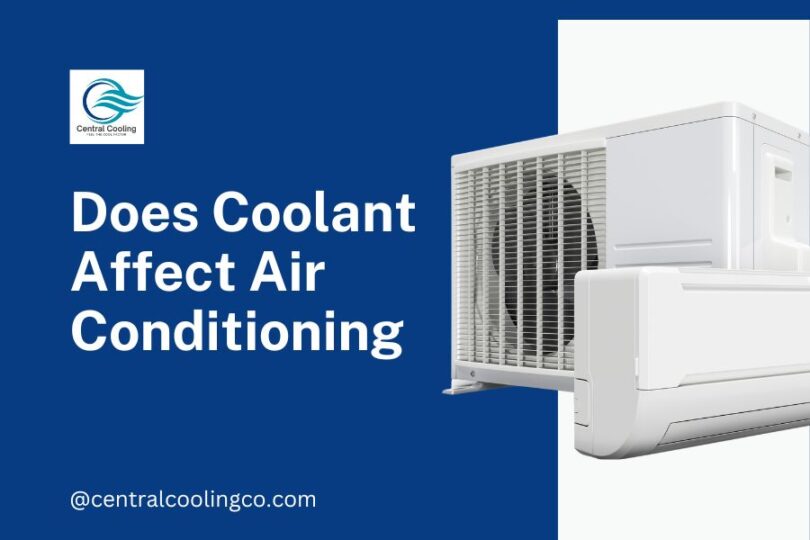Introduction:
Air conditioning is an essential aspect of modern life. It provides comfort, improves productivity, and ensures a healthy indoor environment. The basic principle of air conditioning involves the removal of heat from a space to make it cooler. This process relies heavily on a substance called a coolant or refrigerant. Does Coolant Affect Air Conditioning? Learn about the essential role of coolant in keeping your indoor environment comfortable and cool.
Coolants are the lifeblood of air conditioning systems, enabling them to achieve the desired cooling effect. Different types of coolants have been used throughout the history of air conditioning, and their impact on system performance, energy efficiency, and the environment has evolved. In this essay, we will explore the multifaceted relationship between coolants and air conditioning.
The Role of Coolant In Air Conditioning:
Heat Transfer:
Air conditioning systems operate on the principle of heat transfer. They move heat from one location to another, typically from inside a building to the outdoors. Coolant is the medium through which this heat transfer occurs.
The cycle of operation for an air conditioner typically consists of four main stages: compression, condensation, expansion, and evaporation. Coolant plays a critical role in the condensation and evaporation stages.
In the condensation stage, the hot and high-pressure coolant releases heat as it changes from a gas to a liquid. This process occurs in the outdoor unit of an air conditioner. The coolant is cooled down and becomes a high-pressure liquid.
The high-pressure liquid coolant can expand and evaporate in the indoor unit in the expansion stage. This evaporation process absorbs indoor air heat, cooling it down. The coolant then becomes a low-pressure gas, and the cycle repeats.
Cooling Efficiency:
The choice of coolant significantly impacts the efficiency of an air conditioning system. Coolants have varying heat transfer properties, affecting the system’s cooling capacity. A more efficient coolant can absorb and release heat more effectively, allowing the air conditioner to cool a space more quickly and maintain a lower temperature.
Moreover, the efficiency of the cooling process is also influenced by the specific heat capacity and thermal conductivity of the coolant. Coolants with higher specific heat capacities can store more heat energy, while those with excellent thermal conductivity can transfer heat more rapidly. These properties can lead to a more efficient cooling process and a more comfortable indoor environment.
Refrigeration Cycle:
Air conditioning systems rely on a continuous refrigeration cycle to maintain a consistent cooling effect. This cycle depends on the unique properties of the coolant. When the coolant changes between its gaseous and liquid states, it absorbs and releases heat, enabling the system to maintain a desired temperature within a building.
The ability of the coolant to change states at specific temperatures and pressures is crucial for maintaining the refrigeration cycle. Coolants have different boiling and condensing points, impacting the air conditioning system’s overall performance and efficiency.
Types Of Coolants:
Throughout the history of air conditioning, various types of coolants have been used. These coolants can be broadly categorized into two groups: traditional refrigerants and modern refrigerants.
Traditional Refrigerants:
Traditional refrigerants, such as chlorofluorocarbons (CFCs) and hydrochlorofluorocarbons (HCFCs), were commonly used in older air conditioning systems. However, their use has been phased out due to their detrimental environmental impact. CFCs, for example, were found to be responsible for ozone layer depletion, leading to the signing of the Montreal Protocol in 1987, which aimed to phase out their use.
The environmental concerns associated with traditional refrigerants led to the development of alternative, more eco-friendly options.
Modern Refrigerants:
Modern refrigerants, including hydrofluorocarbons (HFCs) and hydro fluorolefin (HFOs), have been developed to replace traditional refrigerants. These alternatives are designed to have lower environmental impacts, particularly regarding ozone depletion and global warming potential.
HFCs, for example, do not deplete the ozone layer, but they have a high global warming potential (GWP), a measure of their contribution to climate change. In response, HFOs were developed to have significantly lower GWPs.
One notable example of a modern refrigerant is R-410A, commonly used in residential air conditioning systems. R-410A is an HFC with a high cooling capacity and is considered more environmentally friendly than many traditional refrigerants.
Environmental Impact Of Coolants:
The choice of coolant has significant implications for the environment. The environmental impact of coolants is primarily associated with two key factors: ozone depletion and global warming potential.
Ozone Depletion:
Ozone-depleting substances, such as CFCs and HCFCs, were widely used as refrigerants. When released into the atmosphere, these substances have a destructive effect on the ozone layer. The ozone layer protects the Earth from the sun’s harmful ultraviolet (UV) radiation.
The discovery of the ozone hole over Antarctica in the 1980s was a wake-up call that led to international efforts to phase out the use of ozone-depleting refrigerants. This resulted in the Montreal Protocol, which has successfully reduced the production and consumption of these substances.
Modern refrigerants, such as HFCs and HFOs, do not deplete the ozone layer, and this has been a significant step toward environmental protection. However, the shift towards these alternatives brought about another concern: their impact on global warming.
Global Warming Potential (GWP):
Global warming potential (GWP) measures how much a substance contributes to global warming over a specific period compared to carbon dioxide (CO2). CO2 is used as the baseline, with a GWP of 1. Refrigerants, especially HFCs, have been found to have high GWPs, making them potent contributors to climate change.
The environmental impact of air conditioning systems is not limited to their energy consumption; it also includes the GWP of the coolant they use. High-GWP refrigerants can offset the energy efficiency gains the air conditioning system achieves. To address this, efforts are being made to develop low-GWP alternatives and promote adoption.
Impact Of Coolants On Air Conditioning Efficiency:
Air conditioning efficiency is crucial for comfort, energy consumption, and operating costs. The choice of coolant directly impacts the efficiency of air conditioning systems.
Cooling Capacity:
The cooling capacity of an air conditioner is determined by the amount of heat the coolant can absorb and release during the refrigeration cycle. Different coolants have varying heat transfer properties, which can affect the system’s cooling capacity.
Efficient coolants can absorb and release heat more effectively, resulting in a higher cooling capacity. This means the air conditioner can cool a space more quickly and maintain a lower temperature, which is especially important during hot summer months.
Energy Efficiency:
Energy efficiency is a critical consideration in air conditioning, both in terms of cost savings and environmental impact. The efficiency of an air conditioning system is often measured by its seasonal Energy Efficiency Ratio (SEER) or Energy Efficiency Ratio (EER).
The choice of coolant can influence these efficiency metrics. Coolants with better heat transfer properties can lead to higher EER and SEER ratings. These high-efficiency systems consume less electricity to achieve the desired cooling effect, which results in lower energy bills and reduced greenhouse gas emissions.
System Design:
The choice of coolant also impacts the design of air conditioning systems. Different coolants may require specific components, such as compressors and heat exchangers, to optimize performance. This can influence the overall design and cost of the system.
For example, systems designed for use with high-GWP refrigerants may need additional components for leakage detection and prevention and improved insulation to reduce emissions. On the other hand, systems using low-GWP refrigerants may have a more straightforward design, which can lead to cost savings.
Regulatory And Industry Changes:
In recent years, there have been significant regulatory and industry changes related to the use of refrigerants in air conditioning systems. These changes are driven by a growing awareness of the environmental impact of coolants and a commitment to mitigating their effects.
Phasing Out High-GWP Refrigerants:
One of the most notable changes is the phase-out of high-GWP refrigerants, particularly HFCs, in many regions. The Kigali Amendment to the Montreal Protocol, agreed upon in 2016, outlines a global effort to reduce HFC production and consumption. This international agreement aims to curb the environmental impact of these potent greenhouse gases.
As a result of this amendment, many countries are implementing regulations and policies to transition to low-GWP refrigerants. These changes have significant implications for the air conditioning industry, as manufacturers must adapt to the new rules and produce equipment compatible with the approved refrigerants.
Adoption Of Low-GWP Alternatives:
The air conditioning industry is adopting low-GWP refrigerants to meet the changing regulatory landscape and consumer demand for more environmentally friendly solutions. These alternatives are designed to provide similar or improved cooling performance while minimizing environmental impact.
Low-GWP refrigerants, such as HFOs, and natural refrigerants, like R-290 (propane) and R-744 (carbon dioxide), have recently gained popularity. These alternatives offer a way to maintain efficient air conditioning systems while reducing the carbon footprint associated with cooling.
Research and Development:
The need for more sustainable cooling solutions has driven significant research and development efforts in refrigerants. Researchers are exploring innovative materials and technologies to enhance air conditioning systems’ efficiency and environmental friendliness.
One area of research involves using natural refrigerants, such as hydrocarbons and carbon dioxide. These substances have low GWPs and are abundant, making them attractive choices for environmentally conscious air conditioning systems.
Another area of interest is the development of refrigerants with improved thermodynamic properties, allowing for even greater energy efficiency. Advanced heat pump systems and alternative technologies like magnetic cooling are also being explored to reduce energy consumption.
Conclusion:
The continuous evolution of the HVAC industry underscores the critical importance of refrigerants in air conditioning systems. As society increasingly prioritizes environmental sustainability, the shift from high-GWP refrigerants to low-GWP alternatives reflects a collective commitment to mitigating climate change. However, this transition entails more than just swapping out refrigerants; it necessitates comprehensive system modifications and industry-wide adaptations. Manufacturers are tasked with developing equipment compatible with approved refrigerants, while researchers explore innovative solutions to enhance efficiency and reduce environmental impact further. Moreover, regulatory changes and consumer demand are driving the adoption of sustainable cooling technologies, such as natural refrigerants and advanced heat pump systems. By navigating these challenges and embracing sustainable practices, the HVAC industry can uphold its mission of providing comfortable indoor environments while safeguarding the planet for future generations.
Disclosure: We may get commissions for purchases made through links in this post.








